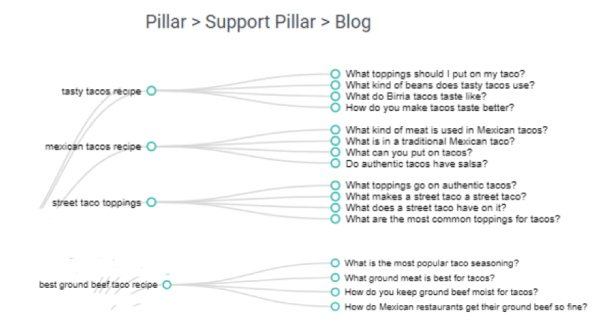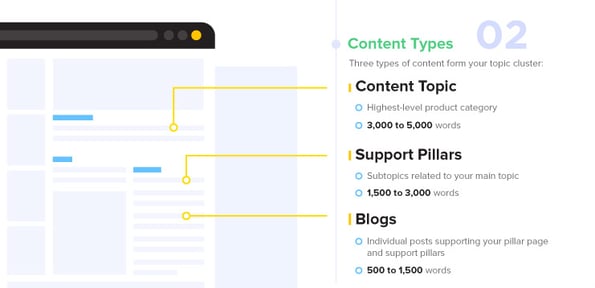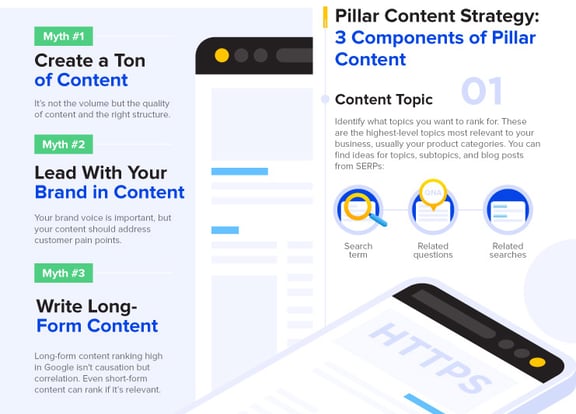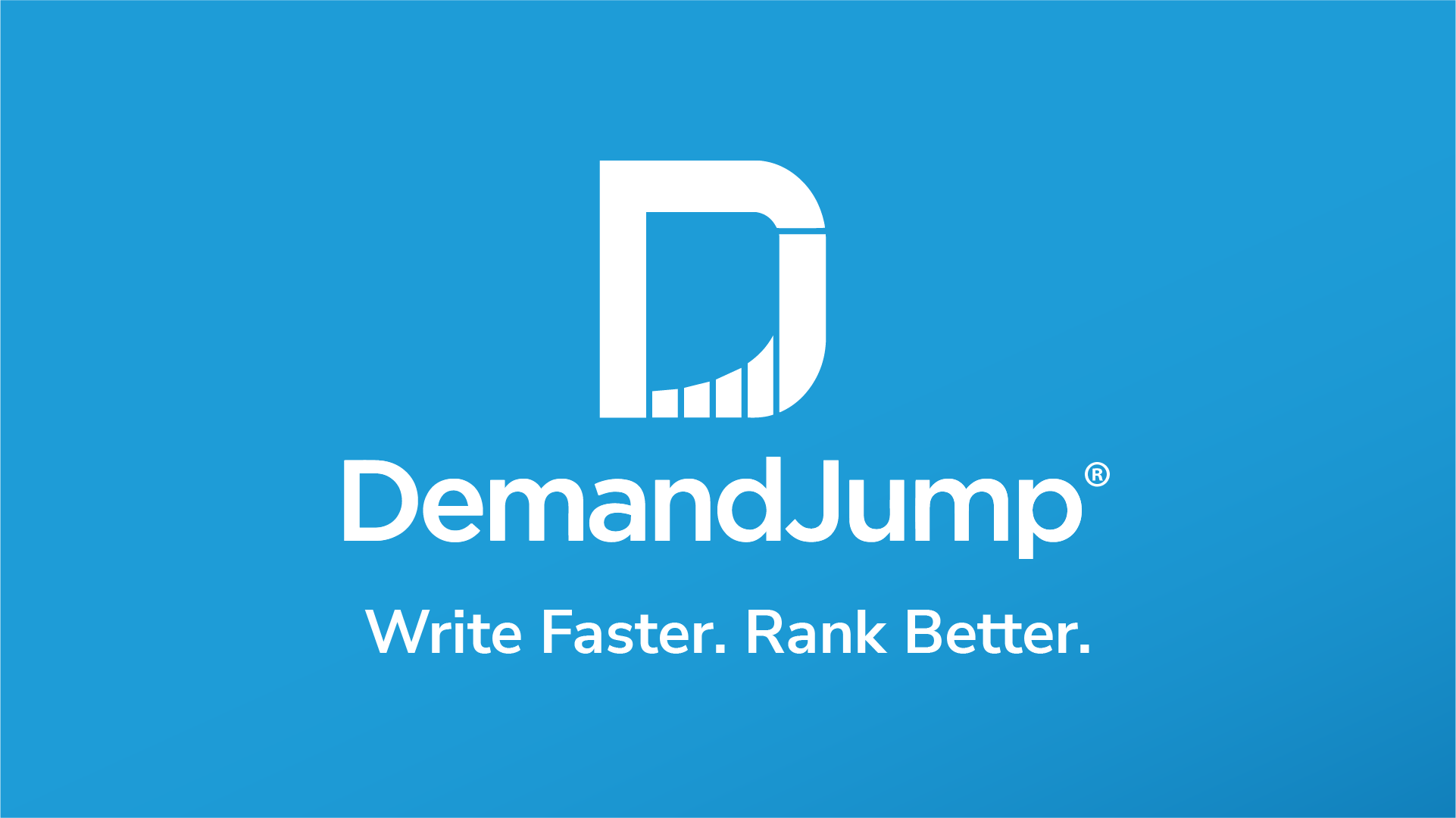It’s common knowledge that Google’s search algorithms have become much more sophisticated in recent years. Google no longer relies solely on keywords to evaluate content. Instead, it’s focused on ranking sites that are considered to be authorities on specific topics. This means that simply keyword stuffing just to get traffic no longer gets you a spot on page 1.
But how do you become an established authority and write content that appeals to Google’s algorithm? Use an SEO pillar strategy of course! Creating topic clusters and writing pillar content plays a crucial role in developing your digital authority. Covering a broad topic from all angles using targeted SEO keyword research, you’ll create content that is exactly what your audience is looking for and what search engines value.
In this basic guide, we’ll explain how to create a pillar page using pillar page best practices and give you some examples of what all of this looks like in practice.
What Is a Pillar Page?
A pillar page is the largest and most expansive piece of content in a content cluster. But what is a content cluster? We’re glad you asked! Basically, a content cluster is a network of related content. Each piece of content in the cluster ultimately links back to the main pillar page, making it all one cohesive body of work. A content cluster is made up of the following types of written content:
Pillar page: Around 3,000 words
Sub-pillars: Around 2,000 words
Blogs: Around 750 words
So, how many pillar pages should you have? All you need is one pillar page for each topic cluster. The pillar page functions as a masterpiece of content that demonstrates your authority or knowledge about a topic you want to rank for in search engines.
You then can choose related sub-topics to use for your shorter support pillars and blogs, all of which link back to the main pillar page. Using pillar pages and content clusters gives you the ability to capture traffic from Google by increasing your brand’s overall authority.
What Should My Content Pillars Be?
Generating content pillar ideas for your content pillar strategy revolves around answering three main questions:
- How old are they?
- What is their profession?
- Where are they located?
- What are they interested in?
- What are their pain points?
- What are they searching for?
- What do you bring to the table?
- How can you help your audience?
- What is valuable about your organization?
- Why are you the best at what you do?
These are all key concepts you should keep in mind when organizing your pillar strategy and choosing the topics of your pillar content. But we’d be remiss if we didn’t acknowledge the elephant in the room…knowing exactly what your target audience is looking for is the most difficult part of creating a content pillar strategy.
Manually combing through Google to find related searches and commonly asked questions is a painstaking and usually ineffective process. The sad reality is that an unfathomable amount of content is produced every day on the internet, and 90% of it never connects with a single living soul.
This is why most successful content strategies use a content marketing platform to help with this critical point in the pillar process. At DemandJump we deliver consumer behavior insight reports which are designed to uncover the most important topics, questions, and keywords your team should be focusing on.
Automating your competitive research saves you time and delivers the results you need - because why would you spend your time writing content that no one is going to see? You can test out DemandJump for free and see for yourself.

Keyword Research Is...Well, Key
Not only do keywords inform the topic of your pillar, but they also inform how your pillar should be structured. To create an effective pillar page that ranks, you need to include a mix of high-value short-tail and long-tail keywords throughout your pillar piece.
Each of these keywords represents commonly searched phrases related to your broad pillar topic - which means this is the stuff your target audience is looking for. If you choose the wrong keywords or fail to optimize for the right keywords, your pillar won’t rank on search engines and potential customers won’t land on your website.
When you get your keyword research and SEO right, your content will rank better which means more people will interact with your website and see what you have to offer!
What Should a Pillar Page Look Like?
Let’s take a look at a content pillar template to help you get a feel for how you should organize the content itself. Here are some content cluster ideas that the DemandJump platform was able to generate surrounding the topic of “Tasty Tacos.”
Pillar: Tasty Tacos
Sub-pillar: Tasty Tacos Recipe
Supporting Blog: How Do You Make Tacos Taste Better?
Sub-pillar 1: Mexican Tacos Recipe
Supporting blog: What Kind of Meat is Used in Mexican Tacos?
Supporting blog: What is in a Traditional Mexican Taco?
Sub-pillar 2: Street Taco Toppings
Supporting Blog: What Toppings Go on Authentic Tacos?
Supporting Blog: What Makes a Street Taco a Street Taco?
Sub-pillar 3: Best Ground Beef Taco Recipe
Supporting Blog: What Ground Meat is Best for Tacos?
Supporting Blog: How Do You Keep Ground Beef Moist For Tacos?
This is what your suggested pillar strategy would look like as a cluster in the DemandJump platform:

Here are a few keywords to include in the Tasty Taco pillar, as recommended by the DemandJump platform:
- Tasty tacos delivery
- Tasty tacos food truck
- Easy beef taco recipe
- Creative taco toppings
- How many calories are in a restaurant taco?
- What makes a good taco?
- What are the best tacos made of?

Content Pillar Examples
Alright, so you’ve done your keyword research and decided on a topic you want to rank for. Now you can start writing! Easier said than done, right? When it comes to writing your pillar page, you can write in whatever style your heart desires - within reason. For example, content pillars for a small business are going to look very different from content pillars for large corporations. The success of your pillar page is influenced by how valuable your content is and how solid your SEO strategy is.
You can really write in any style you want so long as you have those two concepts locked down, and are writing in a way that will resonate with your target audience. But if you’re looking for a way to get your creative writing juices flowing, here are a few common types of pillar pages that you can reference as you write.
Resource Pillar Page
Reel in your audience with tips and tricks in a resource pillar page. In this style of pillar page, you can really strut your stuff and show off what you know. This is your chance to provide your audience with valuable and informed information.
A resource style pillar page can include checklists, tools, best practices, stats, examples, case studies, and more. Since these resources function well as stand-alone sections, it’s fairly easy to turn those resources into additional forms of content like downloads or social media graphics.
Product or Service Pillar Page
This style of pillar page allows you to specifically focus on what you are offering. Now, this doesn’t mean your pillar should be a long ad campaign where you only plug your brand. Rather, you should focus on creating a guide to a topic that is directly related to what your company does.
For example, an SEO agency could write a pillar all about content creation. This pillar would act as a guide to content creation and allow that agency to highlight their specific services while offering valuable and helpful insight into content creation as a whole.
Guide Pillar Pages
These pillar pages are a great way to establish your authority and create something for your audience to refer back to. Guide pillar pages often explain how to do something or answer a “what is…” question. When writing a guide style pillar page, it’s helpful to identify your audience’s pain points and help guide them through the problem in the pillar. This is also a great way to highlight how your products or services can help solve the issue at hand.
Let’s Build a Pillar!
Using our “Tasty Tacos” pillar example, take a look at how you could go about building a “guide” style pillar page to rank for this topic.
Choose Your Title
As a rule, the phrase you want to rank for should be the title of your blog. However, you do have some wiggle room. For our Tasty Tacos pillar we could say something like: “How To Make Tasty Tacos.” You can edit your title however you see fit so long as the keyphrase you want to rank for remains intact. For formatting, you should use the H1 function in whatever writing platform you’re using.
Create Your Sections
Now it’s time to write the body of your pillar page. Since a pillar is a fairly long piece of content, it’s important to resist the temptation to ramble. Each section should flow together and ultimately relate to the main idea or thesis statement of your pillar.
It’s often helpful to outline the headings and keywords for each section before you start writing. This allows you to see if everything flows together or if some sections should be placed differently within the pillar. For our Tasty Taco example the sections for that pillar could look like:
- How many calories are in a restaurant taco?
- What makes a good taco?
- What are the best tacos made of?
Write a Conclusion That Brings it All Together
Your conclusion should neatly and concisely summarize the main idea of your pillar page while enticing the reader to take a desired action, like buying your product or service! How do you get the reader to take action?
Easy, write a killer CTA. A CTA (Call To Action) is a short and catchy soundbite that directs the reader to do something after having read your content. This could be anything from signing up for a free trial or calling one of your sales representatives to set up an introduction. Here’s a sample CTA for our Tasty Taco pillar:
“We bet you’re hungry after reading all of those delectable taco facts. Go ahead and treat yourself to a free tasty taco - we won’t judge.”
Design Your Pillar
Congratulations! You’ve finished writing! Now it’s time to get your pillar page posted to your website. Every pillar page design is different depending on your brand and the layout of your website but there are a few things that all pillar pages should come with:
- Eye-catching graphics and images
- Easy to read font style
- Multiple links to what you’re selling
- Links to relevant resources on your website
Take a look at our SEO pillar page to see what all of this can look like in practice.

Create In Demand Content With DemandJump
Building a pillar strategy and writing a pillar page all by yourself is a lot of work with no guaranteed payoff. When creating a pillar strategy, you want to do everything exactly right. Why not get some help? DemandJump’s platform lets you build a content pillar strategy for your business in two simple steps:
Step 1: Run an insight report about your topic.
DemandJump’s platform lets you gain access to the highest-value keywords and questions, where you’re currently ranking, and more with just a click of a button. Simply generate an insight report about a topic you want to rank for and let DemandJump do the rest.
Step 2: Build out your pillar strategy.
DemandJump has an entire dashboard built to develop a pillar strategy catered to your needs. It’ll show you exactly which pieces should be sub-pillars and which should be supporting blogs and generate tailored keyword recommendations for every piece of content you create.
It sounds too good to be true, but we promise it’s not. Find out for yourself and start for free today!














